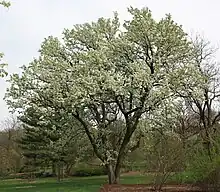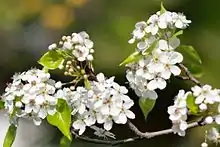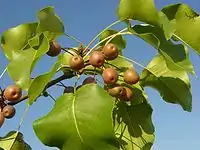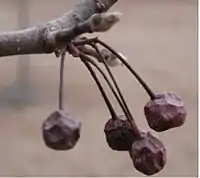| Pyrus calleryana | |
|---|---|
 | |
 | |
| Scientific classification | |
| Kingdom: | Plantae |
| Clade: | Tracheophytes |
| Clade: | Angiosperms |
| Clade: | Eudicots |
| Clade: | Rosids |
| Order: | Rosales |
| Family: | Rosaceae |
| Genus: | Pyrus |
| Species: | P. calleryana |
| Binomial name | |
| Pyrus calleryana | |
| Synonyms[1] | |
|
List
| |
Pyrus calleryana, also known as the Callery pear or Bradford pear, is a species of pear tree native to China and Vietnam,[2] in the family Rosaceae. It is most commonly known for its cultivar 'Bradford' and its offensive odor, widely planted throughout the United States and increasingly regarded as an invasive species.[2]
Pyrus calleryana is deciduous, growing to 5 to 8 m (16 to 26 ft) tall,[3] often with a conical to rounded crown. The leaves are oval, 4 to 8 cm (1+1⁄2 to 3 in) long, glossy dark green above and pale beneath. They have long petioles alternately arranged on branches.[4] The white, five-petaled flowers are about 2 to 2.5 cm (3⁄4 to 1 in) in diameter. They are produced abundantly in early spring, before the leaves expand fully.
The fruits (which are often assumed to be inedible due to their abundant, cyanide laced seeds) of the Callery pear are small (less than 1 centimetre (3⁄8 in) in diameter), and hard, almost woody, until softened by frost, after which they are readily taken by birds, which disperse the seeds in their droppings. In summer, the shining foliage is dark green and very smooth, and in autumn the leaves commonly turn brilliant colors, ranging from yellow and orange to more commonly red, pink, purple, and bronze. However, since the color often develops very late in autumn, the leaves may be killed by a hard frost before full color can develop.
Callery pears are remarkably resistant to disease or fireblight. However, some cultivars, such as 'Bradford', are particularly susceptible to storm damage and are regularly disfigured or killed by strong winds, winter weather, or limb loss due to their naturally rapid growth rate.
The species is named after the Italian-French Joseph-Marie Callery (1810–1862), a sinologue who sent specimens of the tree to Europe from China.[5][6]
Cultivation
Numerous cultivars of Callery pear are offered commercially, including 'Aristocrat', 'Autumn Blaze', 'Bradford', 'Capital', 'Chanticleer' (also known as 'Cleveland Select'), 'New Bradford', 'Redspire', and 'Whitehouse'.

 Autumn color
Autumn color Autumn color
Autumn color
In the United States
The trees were introduced to the U.S. by the United States Department of Agriculture facility at Glenn Dale, Maryland, as ornamental landscape trees in the mid-1960s. They became popular with landscapers because they were inexpensive, transported well and grew quickly. Lady Bird Johnson promoted the tree in 1966 by planting one in downtown Washington, D.C.[7][8] The New York Times also promoted the tree saying, "Few trees possess every desired attribute, but the Bradford ornamental pear comes unusually close to the ideal."[9]
In much of North America these cultivars, particularly 'Bradford', are widely planted as ornamental trees. The trees are tolerant of a variety of soil types, drainage levels, and soil acidity. Their crown shape varies from ovate to elliptical, but may become asymmetric from limb loss due to excessive and unstable growth rate. The initial symmetry of several cultivars leads to their attempted use in settings such as industrial parks, streets, shopping centers, and office parks. Their dense clusters of white blossoms are conspicuous in early spring, with an odor often compared to rotting fish or semen.[10][11][12][13] According to extension specialist Kelly Oten of North Carolina State University, the smell attracts flies which are the primary pollinators rather than bees.[14] At the latitude of Pittsburgh, Pennsylvania, the trees often remain green until mid-November, and in warm autumns, the colors are often bright, although in a cold year they may get frozen off before coloring. In the South, Callery pears tend to be among the more reliable coloring trees.
Subtaxa
The following varieties are currently accepted:[1]
- Pyrus calleryana var. calleryana – China, Japan, and Vietnam, introduced to the United States and Iraq
- Pyrus calleryana var. fauriei (C.K.Schneid.) Rehder – Korea
- Pyrus calleryana var. integrifolia T.T.Yu – China
- Pyrus calleryana var. koehnei (C.K.Schneid.) T.T.Yu – China
- Pyrus calleryana var. lanceata Rehder – China
As an invasive species
The Bradford pear and related cultivars of Pyrus calleryana are regarded as invasive species in many areas of the Eastern and Midwestern regions in North America, outcompeting many native plants and trees.[2] In the northeastern United States, wild Callery pears sometimes form extensive, nearly homogeneous stands in old fields, along roadsides, and in similar disturbed areas. The species was first noticed spreading outside of human cultivation in the 1990s, and by the latter half of the 2000s, Callery pear trees were widespread and could be found in habitats ranging from wetlands to forests.[15]
While various cultivars of the Callery pear are commonly planted for their ornamental value, their prolifically produced fruits are taken by birds, which disperse the seeds in their droppings. The various cultivars are generally themselves self-incompatible, unable to produce fertile seeds when self-pollinated, or cross-pollinated with another tree of the same cultivar. However, if different cultivars of Callery pears are grown in proximity (within insect-pollination distance, about 300 ft or 100 m),[2] they often produce fertile seeds that can sprout and establish wherever they are dispersed. The resulting wild individuals, of various genetic backgrounds, can in turn interbreed, producing more viable seed and furthering expansion and dispersal of the wild stand of the species. These plants often differ from the selected cultivars in their irregular crown shape and (sometimes) presence of thorns.
Callery pear is reported as established outside cultivation in 152 counties in 25 states in the United States.[16] While these wild plants are sometimes called "Bradford pear" (for the 'Bradford' cultivar), they are actually wild-growing descendants of multiple genotypes of Pyrus calleryana, and hence more correctly referred to by the common (or scientific) name of the species itself.[2] Currently, the spread of the invasive trees is limited by their intolerance to extreme cold, but they are creeping northward as climate change causes warming temperatures, and have been found as far north as Madison, Wisconsin.[17]
The Bradford pear in particular has become further regarded as a nuisance tree for its initially neat, dense upward growth, which made it desirable in cramped urban spaces. Without corrective selective pruning at an early stage, these weak crotches result in a multitude of narrow, weak forks that are very susceptible to storm damage. Because of this, and the resulting relatively short life span (typically less than 25 years), many groups have discouraged further planting of 'Bradford' and other similarly structurally deficient Callery pear cultivars (such as 'Cleveland Select') in favor of increasing use of locally native ornamental tree species.[18]
In 2023, the state of Ohio banned the sale and cultivation of Callery pear trees.[19]

 In winter
In winter
Uses
Pear wood (of any species) is among the finest-textured of all fruitwoods. It is prized for making woodwind instruments, and pear veneer is used in fine furniture.[20] Pear wood is also among those preferred for preparing woodcuts for printing, either end-grained for small works or side-grained for larger.[21]
Callery pear has been used as rootstock for grafting such pear cultivars as Comice, Bosc, or Seckel, and especially for Nashi. Pyrus calleryana was first introduced into the United States in 1909 and 1916, largely influenced by the dedicated research of Frank N. Meyer, plant explorer for the US Department of Agriculture, commonly known for the discovery of the Meyer lemon, for agricultural experimentation, pre-dating recognition in the 1950s of the species' potential as an ornamental plant.[2]
References
- 1 2 "Pyrus calleryana Decne". Plants of the World Online. Board of Trustees of the Royal Botanic Gardens, Kew. 2017. Retrieved 22 September 2020.
- 1 2 3 4 5 6 Swearingen, J.; B. Slattery; K. Reshetiloff & S. Zwicker (2010). Plant Invaders of Mid-Atlantic Natural Areas (4th ed.). Washington, D.C.: National Park Service and U.S. Fish and Wildlife Service. p. 168.
- ↑ Gu, Cuizhi; Spongberg, Stephen A. "Pyrus calleryana". Flora of China. Vol. 9 – via eFloras.org, Missouri Botanical Garden, St. Louis, MO & Harvard University Herbaria, Cambridge, MA.
- ↑ "Callery pear (Bradford pear), Pyrus calleryana Rosales: Rosaceae". www.invasive.org. Retrieved 2023-10-23.
- ↑ Reimer, F.C., "A promising new pear stock," The Monthly Bulletin, California State Commission of Horticulture, 5:5 (May 1916), p. 167.
- ↑ Bretschneider, Emil (1898), History of European botanical discoveries in China, vol. 1, Sampson Low, p. 525, ISBN 9783863471651
- ↑ Popkin, Gabriel (2016-03-18). "Opinion | The Ups and Downs of the Bradford Pear". The New York Times. ISSN 0362-4331. Retrieved 2019-03-23.
- ↑ "The Curse of the Bradford Pear: What you should know about the trees and their problems". The Greenville News. Retrieved 2019-03-23.
- ↑ "BRADFORD PEAR HAS MANY ASSETS; New Ornamental Fruit Offers Sturdy Form and Early Bloom". The New York Times. 1964-01-05. ISSN 0362-4331. Retrieved 2019-03-23.
- ↑ Pyrus calleryana at Floridata
- ↑ Reid, Liz (24 April 2015). "What's That Smell? The Beautiful Tree That's Causing Quite a Stink" (Web publication). National Public Radio. Core Publisher. Retrieved 23 November 2019.
- ↑ Morgans, Julian (October 18, 2017). "Here's Why the Trees on Your Street Smell Like Semen". Vice.
- ↑ Spector, Dina (April 26, 2013). "Why All Of New York City Smells Like Sex". Business Insider Australia.
- ↑ Cataudella, Kimberly (March 12, 2022). "'Bounty' offered on invasive Bradford pear trees in NC". News and Observer.
- ↑ Culley, Theresa M. (2017). "The Rise and Fall of the Ornamental Callery Pear Tree". Arnold. 74 (3): 8.
- ↑ Vincent, M.A. (2005). "On the spread and current distribution of Pyrus calleryana in the United States". Castanea. 70 (9): 20–31. doi:10.2179/0008-7475(2005)070[0020:OTSACD]2.0.CO;2. PMC 4103147. PMID 25202586.
- ↑ Culley, Theresa M. (2017). "The Rise and Fall of the Ornamental Callery Pear Tree". Arnold. 74 (3): 10.
- ↑ Lawson, Nancy. "Plant This, Not That! Choose native plants to help put your garden to work for wildlife". The Humane Society of the United States. Retrieved 17 Jan 2016.
- ↑ McEwan, Ryan W. (8 March 2023). "Once the Callery pear tree was landscapers' favorite – now states are banning this invasive species and urging homeowners to cut it down". TheConversation. Retrieved 10 March 2023.
- ↑ Ohio State University Pyrus calleryana Archived 2012-02-22 at the Wayback Machine
- ↑ Escher, M.C. The Graphic Work of M. C. Escher. Pub: Oldbourne Book Co. London. 1961. page 9
External links
- Plant Invaders of Mid-Atlantic Natural Areas
- Pyrus calleryana images at bioimages.vanderbilt.edu
- "Scientists Look for Clues Into How Tree Populations Become Invasive" Jan 15, 2008 by Stacy Kish, CSREES Staff.
- "Pyrus calleryana". Plants for a Future.
- Pyrus calleryana in the CalPhotos photo database, University of California, Berkeley